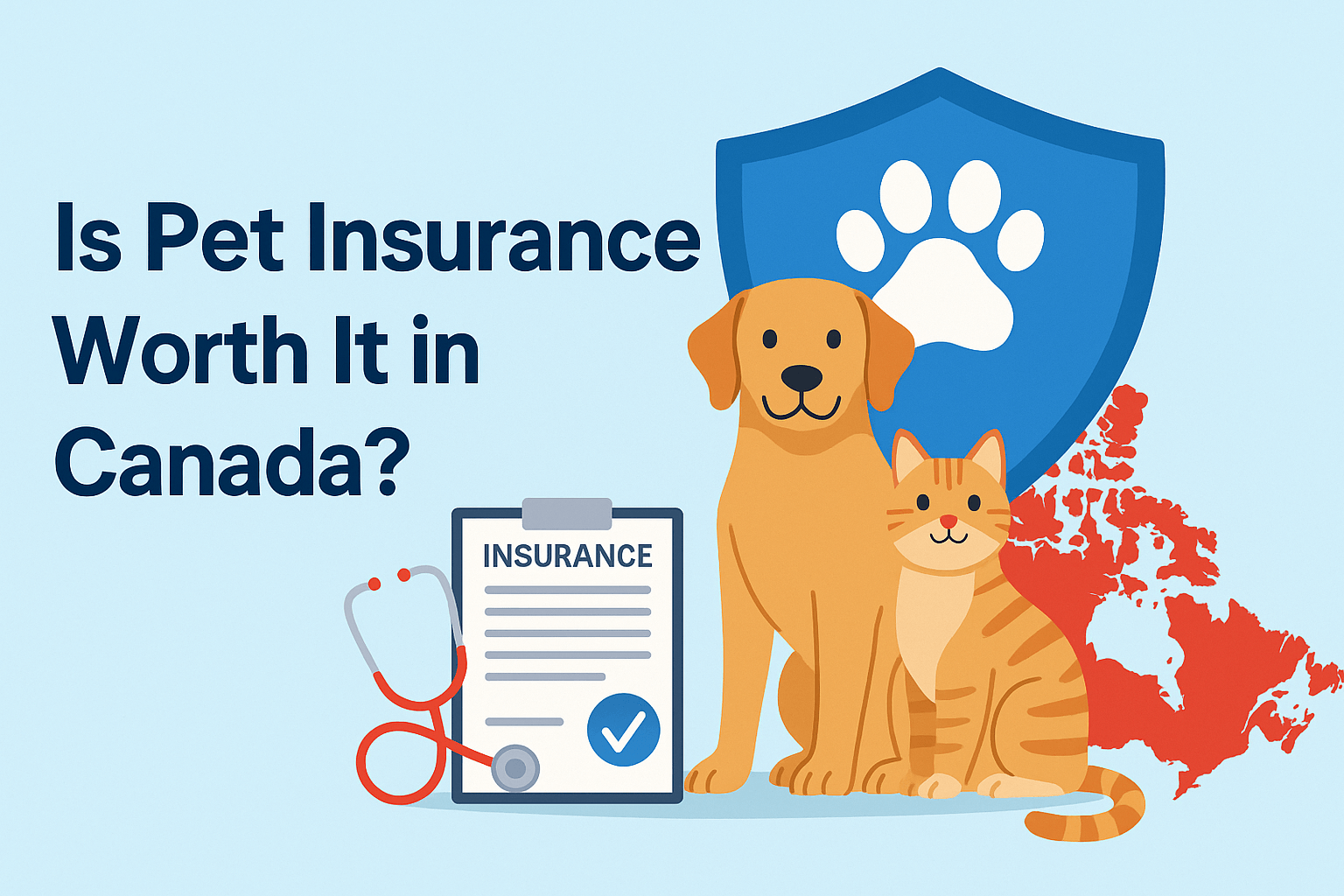As a pet owner in Canada, you treat your furry friend like family. But when unexpected vet bills hit, the costs can add up fast—sometimes thousands of dollars for a single emergency. With veterinary care prices rising by 23.3% from 2021 to 2024, many Canadians are asking: Is pet insurance worth it in Canada? As a personal finance and pet care writer based in Canada, I’ve dug into the numbers, talked to pet owners, and researched the market to help you decide. In this 1500-word guide, I’ll break down the pros, cons, costs, and real-world scenarios to help you figure out if pet insurance is a smart choice for you and your pet. Let’s get into it.
Why Consider Pet Insurance in Canada?
Pets bring joy, but they also come with financial responsibilities. A routine vet visit might cost $100–$200, but emergencies like a broken leg or cancer treatment can run $3,000–$10,000 or more. Pet insurance acts like a safety net, covering a portion of these costs so you can focus on your pet’s health instead of your bank account.
In Canada, only about 3% of pet owners have insurance, compared to 60% of households owning a cat or dog. With vet costs climbing faster than inflation (6–8% annually), pet insurance is becoming a hotter topic. But is pet insurance worth it in Canada for you? It depends on your pet’s needs, your budget, and your risk tolerance. Let’s explore the key factors.
How Pet Insurance Works in Canada
Pet insurance in Canada is similar to human health insurance. You pay a monthly premium, and in return, the insurer covers a percentage of eligible vet bills (typically 70–90%) after you meet a deductible. Policies vary widely, so understanding the basics is key:
- Coverage Types:
- Accident-Only Plans: Cover injuries like broken bones or swallowed objects. These are cheaper but don’t cover illnesses.
- Accident and Illness Plans: Cover accidents, illnesses (e.g., cancer, infections), and sometimes hereditary conditions. These are the most common.
- Wellness Add-Ons: Cover routine care like vaccinations or dental cleanings but increase premiums.
- Key Terms:
- Deductible: The amount you pay out-of-pocket before coverage kicks in (e.g., $100–$500 annually).
- Reimbursement Rate: The percentage of eligible costs covered (e.g., 80%).
- Annual Limit: The maximum the insurer will pay yearly (e.g., $5,000 or unlimited).
- Exclusions: Most plans don’t cover pre-existing conditions, elective procedures (e.g., spaying/neutering), or routine care unless you add wellness coverage.
For example, if your dog needs $5,000 surgery and your plan has a $100 deductible and 80% reimbursement, you’d pay $100 upfront, the insurer covers $3,920 (80% of $4,900), and you’re responsible for $980.
The Pros of Pet Insurance in Canada
Pet insurance can be a lifeline for many pet owners. Here are the top reasons it might be worth it:
- Financial Protection: Vet bills can be staggering. For instance, treating hip dysplasia in a large dog like a Great Dane can cost $8,000. Insurance covers most of this, saving you from draining your savings or facing tough choices about care.
- Peace of Mind: Knowing you can afford emergency care lets you focus on your pet’s recovery. As one Reddit user put it, “I got pet insurance not to save money, but to avoid making medical decisions based on cost.”
- Covers Unexpected Issues: One in three pets needs emergency care annually, from swallowing a toy to developing cancer. Insurance ensures you’re prepared.
- Customizable Plans: Providers like Furkin and Fetch let you adjust deductibles, reimbursement rates, and annual limits to fit your budget.
- Access to Any Vet: Most Canadian insurers, like Trupanion and Petsecure, let you visit any licensed vet in Canada or the U.S., giving you flexibility.
For example, my friend Sarah in Toronto insured her Labrador, Max, with Trupanion. When Max tore his ACL, the $4,500 surgery was mostly covered, leaving Sarah with just $900 out-of-pocket. Without insurance, she’d have struggled to pay.
The Cons of Pet Insurance in Canada
Pet insurance isn’t perfect. Here are the downsides to consider:
- Cost Can Add Up: Premiums average $50/month for dogs and $30/month for cats, or $600–$1,200 annually for a dog over a decade. If your pet stays healthy, you might pay more in premiums than you get back.
- Exclusions and Limits: Pre-existing conditions (e.g., a prior ear infection) and breed-specific issues (like hip dysplasia in Great Danes) are often excluded. Read the fine print to avoid surprises.
- Deductibles and Co-Pays: You’ll still pay a deductible (e.g., $100–$500) and 10–30% of the bill, which can be significant for major treatments.
- Premium Increases: Premiums often rise as your pet ages or after claims. One pet owner reported a 34% hike after two years.
- Low Adoption Rate: Only 3% of Canadian pet owners have insurance, partly because some find it cost-prohibitive or distrust claims processes.
Victoria Shroff, a pet litigation lawyer, warns that denied claims (often for pre-existing conditions) are common, leaving some owners frustrated.
How Much Does Pet Insurance Cost in Canada?
Costs vary based on your pet’s breed, age, location, and coverage level. According to Forbes Advisor Canada, the average monthly premium is $76 for $5,000 coverage with a $100 deductible and 80% reimbursement. Here’s a breakdown:
- Dogs: $50–$80/month (e.g., $570/year for a young dog, higher for breeds like Great Danes prone to hip issues).
- Cats: $24–$50/month (e.g., $340/year for a young cat). Cats are cheaper because they need less care.
- Factors Affecting Cost:
- Breed: High-risk breeds (e.g., Dogue de Bordeaux) cost more to insure.
- Age: Older pets face higher premiums due to increased health risks.
- Location: Urban areas like Toronto have higher vet costs, increasing premiums.
- Coverage Level: Plans with wellness add-ons or unlimited limits cost more.
For example, insuring a 5-year-old Labrador in Toronto with Petsecure costs $77.65/month for $5,000 coverage, but $203.32 for unlimited coverage.
Is Pet Insurance Worth It in Canada? Key Questions to Ask
To decide if pet insurance is worth it in Canada, ask yourself these questions:
- Can I Afford a Big Vet Bill? If a $5,000 emergency would strain your finances, insurance could be a lifesaver. Most Canadians don’t have enough savings for a $1,500 vet bill.
- What’s My Pet’s Risk Profile? Breeds prone to issues (e.g., Bulldogs with respiratory problems) or older pets benefit more from insurance. Younger, healthier pets may not need it as urgently.
- Do I Value Peace of Mind? Insurance lets you say “yes” to treatment without hesitation, as one pet owner did for her dog’s $3,500 surgery after swallowing a wire.
- Can I Save Instead? Some owners prefer a high-interest savings account (HISA) for pet expenses. But as expert Jessica Moorhouse notes, most people don’t stick to saving consistently.
Top Pet Insurance Providers in Canada
Here are three reputable options to consider, based on coverage and customer reviews:
- Trupanion:
- Pros: 90% reimbursement, direct vet billing, no payout cap, covers hereditary conditions.
- Cons: Higher premiums (e.g., $416/month for a Labrador in BC), no wellness coverage.
- Best For: Owners of high-risk breeds or those wanting lifetime coverage.
- Petsecure:
- Pros: Four plan tiers, covers dental care (with add-ons), multi-pet discounts.
- Cons: Reimbursement can take up to 6 months, 14-day illness waiting period.
- Best For: Owners seeking comprehensive coverage with flexible limits.
- Furkin:
- Pros: Flexible deductibles, covers exam fees and lost pet rewards, no enrollment fees.
- Cons: $20,000 annual limit, no coverage for pre-existing conditions.
- Best For: Budget-conscious owners wanting customizable plans.
Alternatives to Pet Insurance
If pet insurance doesn’t feel worth it in Canada, consider these options:
- High-Interest Savings Account (HISA): Set aside $50–$100/month in a dedicated pet fund. A HISA with 3–4% interest grows your savings while keeping funds accessible.
- Veterinary Financing: Petcard offers loans for vet bills with terms from 6 months to 6 years, paid directly to the vet.
- Preventive Care: Invest in quality food, regular check-ups, and a safe environment to reduce health risks.
For example, my neighbour, Mark, skipped insurance for his cat, Luna, and saved $50/month in a HISA. When Luna needed $2,000 dental surgery, he had enough saved to cover it.
Tips to Maximize Pet Insurance Value
If you decide pet insurance is worth it in Canada, follow these tips to get the most out of your policy:
- Enroll Early: Insure your pet when they’re young and healthy to lock in lower premiums and avoid pre-existing condition exclusions.
- Shop Around: Compare quotes from providers like Trupanion, Petsecure, and Furkin. Use tools like Pet Insurance Review’s quote form for personalized options.
- Read the Fine Print: Check for exclusions (e.g., breed-specific conditions) and waiting periods (e.g., 14 days for illnesses, 6 months for ligament issues).
- Choose the Right Deductible: A higher deductible (e.g., $500) lowers premiums but increases out-of-pocket costs. Balance this with your budget.
- Submit Claims Promptly: Most insurers, like Furkin, require claims within 90 days. Keep vet receipts organized to avoid delays.
Final Thoughts
So, is pet insurance worth it in Canada? It depends on your situation. If your pet is prone to health issues, you live in a high-cost city like Vancouver, or you want peace of mind, pet insurance can be a smart investment. Providers like Trupanion and Petsecure offer robust coverage, with premiums averaging $50–$80/month for dogs and $24–$50 for cats. However, if you have a healthy pet and can save diligently, a HISA might be enough. Weigh your pet’s risks, your financial cushion, and the policy details before deciding.
Ready to explore pet insurance? Get quotes from Trupanion, Petsecure, or Furkin today, or start a pet savings fund to prepare for the unexpected. Your furry friend deserves the best care, and you deserve financial security.


